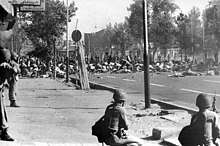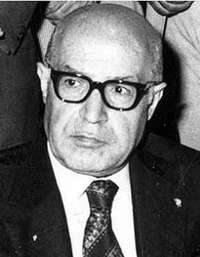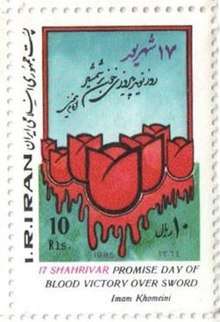Black Friday (1978)
Black Friday (Persian: جمعه سیاه, romanized: Jom'e-ye Siyāh) is the name given to an incident occurring on 8 September 1978 (17 Shahrivar 1357 in the Iranian calendar) in Iran,[7] in which around 88[5] people were shot dead and 205–8,000 injured by the Pahlavi military in Jaleh Square (Persian: میدان ژاله, romanized: Meydān-e Jāleh) in Tehran.[8][9] The deaths were described as the pivotal event in the Iranian Revolution that ended any "hope for compromise" between the protest movement and regime of Shah Mohammad Reza Pahlavi.[10] The incident is described by historian Ervand Abrahamian as "a sea of blood between the shah and the people."[2]
| Black Friday | |
|---|---|
| Part of Iranian Revolution | |
 | |
| Location | Tehran, Iran |
| Date | 8 September 1978 (GMT+3.30) |
| Deaths | 88[1][2][3][4][5][6] |
| Injured | 205[5] |
| Perpetrators | Imperial Army of Iran |
Background

As protests against the Shah's rule continued during the spring and the summer of 1978, the Iranian government declared martial law. On 8 September, thousands gathered in Tehran's Jaleh Square for a religious demonstration, unaware that the government had declared martial law a day earlier.[11]
Massacre
The soldiers ordered the crowd to disperse, but the order was ignored. Initially, it was thought that because of that reason the protesters' continuous pushing towards the military that made it open fire, killing and wounding dozens of people.
Aftermath
.jpg)
Black Friday is thought to have marked the point of no return for the revolution, and it led to the abolition of Iran's monarchy less than a year later. It is also believed that Black Friday played a crucial role in further radicalizing the protest movement, uniting the opposition to the Shah and mobilized the masses. Initially, opposition and western journalists claimed that the Iranian army had massacred thousands of protesters.[1][12][13] The clerical leadership announced that "thousands have been massacred by Zionist troops".[14]
The events triggered protests that continued for another four months. The day after Black Friday, Amir-Abbas Hoveyda resigned as minister of court for unrelated reasons.
A general strike in October shut down the petroleum industry that was essential to the administration's survival, "sealing the Shah's fate".[15] The continuation of protests ultimately led to Shah leaving Iran in January 1979, clearing the way for the Iranian Revolution, led by Ayatollah Ruhollah Khomeini.[16][17][18][19][20][21][22]
Legacy
Initially, Western media and opposition reported "15,000 dead and wounded", but Iranian government officials reported that 86 people had died in Tehran in the whole day.[23][24] French social theorist Michel Foucault first reported that 2,000 to 3,000 people had died in the Jaleh Square, and he later raised that number to 4,000.[1] The BBC's correspondent in Iran, Andrew Whitley, reported that hundreds had died.[25]
According to Emadeddin Baghi, a former researcher at the Martyrs Foundation (Bonyad Shahid, part of the current Iranian government, which compensates families of victims) hired "to make sense of the data" on those killed on Black Friday, 64 were killed in Jaleh Square on Black Friday, with two females: one woman and a young girl. On the same day in other parts of the capital, 24 people died in clashes with martial law forces, with one female, making the total casualties on the same day to 88 deaths.[1] Another source puts the Martyrs Foundation tabulation of dead at 84 during that day.[26]
The square's name was later changed to the Square of Martyrs (Maidan-e Shohada) by the Islamic republic.[13]
Since the 2000s, some former Pahlavi dynasty politicians have suggested greater ambiguity in the situation, in particular the presence of Palestinian guerrillas in Iran, who they believe were agitators.[27][28]
In art
In Persian

In 1978 shortly after the massacre, the Iranian musician Hossein Alizadeh set Siavash Kasraie's poem about the event to music. Mohammad Reza Shajarian sang the piece "Jāleh Khun Shod" (Jaleh [Square] became bloody).[29]
In English
Nastaran Akhavan, one of the survivors, wrote the book Spared about the event. The book explains how the author was forced into a massive wave of thousands of angry protesters, who were later massacred by the Shah's military.[30] The 2016 adventure video game 1979 Revolution: Black Friday is based on the event. The game is directed by Navid Khonsari, who was a child at the time of the revolution and admitted he did not have a realistic view of what was taking place. Khonsari described creating the game as "[wanting] people to feel the passion and the elation of being in the revolution – of feeling that you could possibly make a change."[31]
See also
References
- "A Question of Numbers".
- Shakman Hurd, Elizabeth (2009). The Politics of Secularism in International Relations. Princeton University Press. ISBN 978-1400828012.
- Berg-Sørensen, Anders (2016). Contesting Secularism: Comparative Perspectives. Routledge. ISBN 9781317160243.
- Thiessen, Mark (2008). An Island of Stability: The Islamic Revolution of Iran and the Dutch Opinion. Sidestone Press. ISBN 9789088900198.
- "Emad Baghi :: English". emadbaghi.com. Retrieved 8 September 2018.
- Andrew Scott Cooper,The Fall of Heaven: The Pahlavis and the Final Days of Imperial Iran Hardcover – 19 July 2016 ISBN 0805098976
- Abrahamian, Ervand (21 July 1982). Iran Between Two Revolutions. Princeton University Press. p. 516. ISBN 978-0691101347.
black friday iran.
- Bashiriyeh, Hossein (27 April 2012). The State and Revolution in Iran (RLE Iran D). Taylor & Francis. ISBN 9781136820892.
- Fischer, Michael M. J. (15 July 2003). Iran: From Religious Dispute to Revolution. Univ of Wisconsin Press. ISBN 9780299184735.
- Abrahamian, Ervand, History of Modern Iran, Cambridge University Press, 2008, p. 160–1
- Bakhash, Schaul (1990). The Reign of the Ayatollahs: Iran and the Islamic Revolution. New York: Basic Books. p. 15.
- "Islamic Revolution of Iran". Archived from the original on 28 October 2009.
- "Black Friday". Archived from the original on 20 May 2003.
- Taheri, The Spirit of Allah (1985), p. 223.
- Moin, Khomeini (2000), p. 189.
- The Persian Sphinx: Amir Abbas Hoveyda and the Riddle of the Iranian Revolution, Abbas Milani, pp. 292–293
- Seven Events That Made America America, Larry Schweikart, p.
- The Iranian Revolution of 1978/1979 and How Western Newspapers Reported It, Edgar Klüsener, p. 12
- Cultural History After Foucault, John Neubauer, p. 64
- Islam in the World Today: A Handbook of Politics, Religion, Culture, and Society, by Werner Ende, Udo Steinbach, p. 264
- The A to Z of Iran, John H. Lorentz, p. 63
- Islam and Politics, John L. Esposito, p. 212
- Mohammad Reza Pahlavi, Shah of Iran, 1919–1980. (1980). Answer to History. Toronto: Clarke, Irwin & Co. ISBN 0-7720-1296-2. OCLC 11080339.CS1 maint: multiple names: authors list (link)
- Pahlavi, Mohammad Reza Shah (2003) Answer to History Irwin Pub, page 160, ISBN 978-0772012968
- "Black Friday Massacre – Iran (SEp. 8 1978)". Retrieved 7 June 2013
- E. Baqi, 'Figures for the Dead in the Revolution', Emruz, 30 July 2003, quoted in Abrahamian, Ervand, History of Modern Iran, Cambridge University Press, 2008, pp. 160–1
- Ganji, Manouchehr (2002). Defying the Iranian Revolution: From a Minister to the Shah to a Leader of Resistance. Greenwood Publishing Group. ISBN 978-0-275-97187-8.
- Cooper, Andrew Scott (2 August 2016). The Fall of Heaven: The Pahlavis and the Final Days of Imperial Iran. Macmillan. ISBN 978-0-8050-9897-6.
- Staff writers. "Jales became bloody". asriran.com. Retrieved 7 September 2016.
- Akhavan, Nastaran (3 May 2012). Spared. CreateSpace Independent Publishing Platform. ISBN 978-1463619428.
- Holpuch, Amanda (14 November 2013). "Frag-counter revolutionaries: Iran 1979 revolution-based video game to launch". The Guardian. Archived from the original on 4 March 2016.